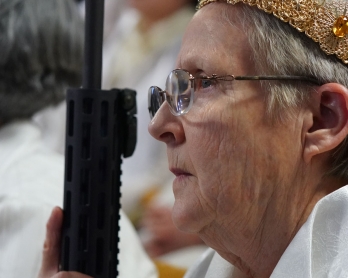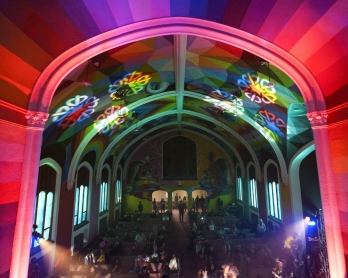Of snakes and faith
Squire, West Virginia, US -- I have always found it fascinating to learn what people will do for their religion. The passion that people will bring and the length they will go to prove their devotion to a higher power.
In my 15 years as photographer, I have had opportunities to photograph all kinds of faithful and their rituals of devotion in various parts of the world. In Sri Lanka, I saw Hindus hang themselves from hooks to show the strength of their faith. In India, I watched as Hindu believers ignored a three-foot-deep (meter-deep) coat of chemical foam floating on top of the Yamuna River to plunge in for their ritual swim.
 An Indian Hindu devotee (R) changes as a boatman bails water from his boat amid polluted foam in the Yamuna river in New Delhi on December 9, 2012. (AFP / Andrew Caballero-reynolds)
An Indian Hindu devotee (R) changes as a boatman bails water from his boat amid polluted foam in the Yamuna river in New Delhi on December 9, 2012. (AFP / Andrew Caballero-reynolds)I just find it captivating to observe the depth of people’s faith. No-one who is not religious is going to do things like that.
So when I moved back to the US to work as a photo editor and backup shooter for AFP in Washington a few years ago, I naturally started looking around for religious stories that I could do.
That’s how I came upon the snake churches. A friend long ago mentioned them off hand -- “you should do a story on the snake churches of Appalachia.” I was intrigued, so I started digging.
In my research, I learned that serpent-handling congregations used to liberally dot the Appalachian Mountains in states like Tennessee, West Virginia and Kentucky.
The faithful use snakes in ceremonies, taking their scriptural mandate from the Bible’s Gospel of Mark 16:17-18 -- “In my name they will drive out demons; they will speak in new tongues, they will pick up snakes with their hands, and when they drink deadly poison, it will not hurt them at all.”
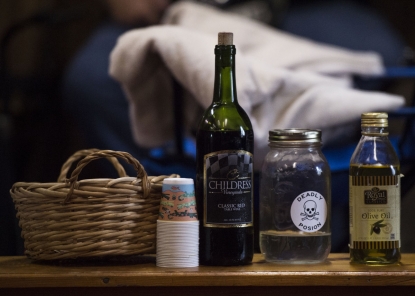 A bottle of strychnine (C), red wine for communion (L), and olive oil for blessings are seen before a Pentecostal serpent handlers service at the House of the Lord Jesus church in Squire, West Virginia on May 27, 2018.
(AFP / Andrew Caballero-reynolds)
A bottle of strychnine (C), red wine for communion (L), and olive oil for blessings are seen before a Pentecostal serpent handlers service at the House of the Lord Jesus church in Squire, West Virginia on May 27, 2018.
(AFP / Andrew Caballero-reynolds)In other words, the parishioners take the Bible at its word -- if it says they won’t be hurt by handling snakes, they won’t be.
Over the past few decades, however, more and more states have outlawed the practice and the churches have gone underground.
Quite a few of the churches were no longer working because the pastors had died of snake bites, or because of the stigma. Today these churches are tiny communities, usually revolved around one family -- the pastorship is passed down from one relative to another and most of the worshippers are family members. So it was a challenge finding them.
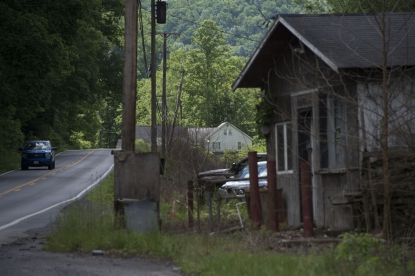 The House of the Lord Jesus church, a Pentecostal serpent handlers church, is seen in the distance in Squire, West Virginia on May 27, 2018.
(AFP / Andrew Caballero-reynolds)
The House of the Lord Jesus church, a Pentecostal serpent handlers church, is seen in the distance in Squire, West Virginia on May 27, 2018.
(AFP / Andrew Caballero-reynolds)I spent months looking. I would first search the Internet and when I came across a photo of a church somewhere, I would then switch to Google Maps and go to that town and drive around until I found a building that looked like what I had found online. I managed to find one in a small town in Tennessee and wrote to them. The address was literally “Snake Church, XXXtown TN.” No-one got back to me. I sent four lettres like that, all with no luck.
Finally I came across a woman named Colleen on Facebook who wrote a book about her congregation. So I contacted her. To say that she was hesitant would be a huge understatement. Basically, she told me “I don’t know you, I don’t trust you. We’ve had lots of people mock us, so I have no interest in talking to you.”
I kept writing back, explaining to her who I was, what I had done previously, sending her the work that I had done before in my various postings. I told her what I have told all my previous subjects -- I think the dedication that you have is commendable and I want to photograph it.
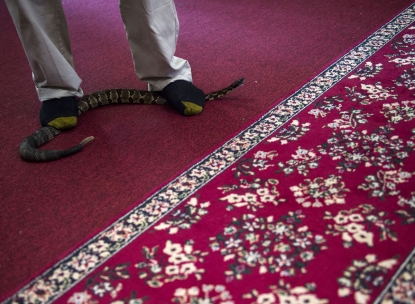 Pastor Chris Wolford steps on a timber rattlesnake during a Pentecostal serpent handlers service at the House of the Lord Jesus church in Squire, West Virginia on May 27, 2018.
(AFP / Andrew Caballero-reynolds)
Pastor Chris Wolford steps on a timber rattlesnake during a Pentecostal serpent handlers service at the House of the Lord Jesus church in Squire, West Virginia on May 27, 2018.
(AFP / Andrew Caballero-reynolds)I could understand her hesitation and resistance. They’ve had media do stories on them before that were less than flattering.
After three to four months of back and forth, she relented a little bit and said that if I read her book, she would see about changing her mind. I of course read it and after that, she was much more open. We spent another few weeks chatting on the phone and finally she gave me the pastor’s name and contact details.
I spent another few weeks chatting with the pastor, Chris Woolford, via Facebook and on the phone. And finally he invited me to a service over the Memorial Day weekend. It turned out to be a very good time to come. It was both a service to honor Chris’s brother, the church’s previous pastor who had died of a snake bite two years before and what they call a homecoming -- when worshippers and believers from other states come for the service.
As always in these stories, I was struck by the devotion.
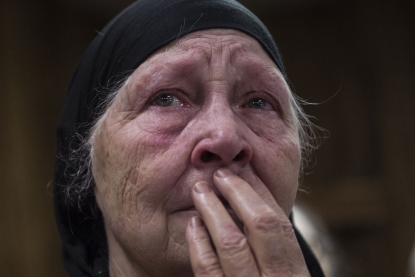 Vicie Haywood, mother of pastor Chris Wolford, cries during a Pentecostal serpent handlers service at the House of the Lord Jesus church in Squire, West Virginia on May 26, 2018.
(AFP / Andrew Caballero-reynolds)
Vicie Haywood, mother of pastor Chris Wolford, cries during a Pentecostal serpent handlers service at the House of the Lord Jesus church in Squire, West Virginia on May 26, 2018.
(AFP / Andrew Caballero-reynolds)Chris was born into the snake-handling church tradition. His father was a pastor and so was his older brother. He always knew that this was something that he wanted to do. It was in his family, in his blood. He was very emotional about it. His mother is a member of the church. So are his sisters and in-laws. Interestingly his wife doesn’t believe in it. But she understands his need for it and they work it out somehow.
What he didn’t expect is to become a pastor so soon. His brother was his mentor and it was a shock when he died of a snake bite two years ao. Chris didn’t think he'd take up the mantle so early.
With so many in the faith dying of snake bites, I posed the obvious question -- why continue doing it?
The answer I got was simple -- if you’re bit by a snake, that means it was your time. To these worshippers, the Bible is to be taken literally -- so if it says that the snake can’t harm you, it means it won’t harm you. If you got bit and die, that means God meant that to be your final moment.
 Pastor Chris Wolford (C) sings as he holds a tiber rattlesnake during a Pentecostal serpent handlers service at the House of the Lord Jesus church in Squire, West Virginia on May 27, 2018.
(AFP / Andrew Caballero-reynolds)
Pastor Chris Wolford (C) sings as he holds a tiber rattlesnake during a Pentecostal serpent handlers service at the House of the Lord Jesus church in Squire, West Virginia on May 27, 2018.
(AFP / Andrew Caballero-reynolds)This church is in West Virginia, the only state where using snakes in worship is legal. Most of these types of churches are family churches, made up of Moms and Dads and brothers and sisters and cousins. Every once in a while someone curious will come in and sometimes after one service, they become believers. Sometimes people hear through the grapevine that the church exists and come in to take a look and stay.
They get their snakes in the mountains and keep them in reptile cages, with heating lights. Usually these are in the church basements, sometimes they’re in pastors’ homes. For the service, they put the snakes into wooden boxes and pull them out when the moment is right.
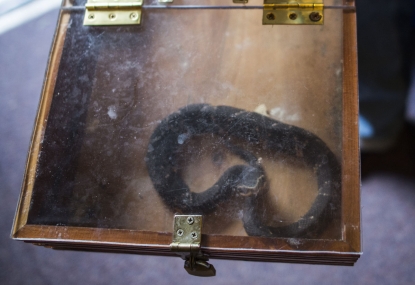 A copperhead snake looks out of a box before a Pentecostal serpent handlers service at the House of the Lord Jesus church in Squire, West Virginia on May 26, 2018.
(AFP / Andrew Caballero-reynolds)
A copperhead snake looks out of a box before a Pentecostal serpent handlers service at the House of the Lord Jesus church in Squire, West Virginia on May 26, 2018.
(AFP / Andrew Caballero-reynolds)The service itself reminded me of evangelical affairs. They start quietly, with a little sermon, where the pastor talks to the crowd and it responds. There is music playing. Slowly, the tempo builds up, with the pastor’s voice and music louder and faster, until you reach a climax, at which part they will either drink the snake poison, or hold lit bottles under their head, or bring out the snakes.
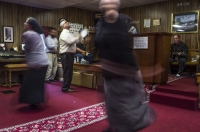
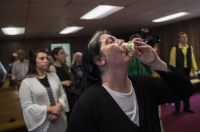
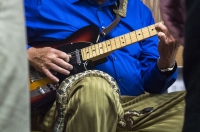
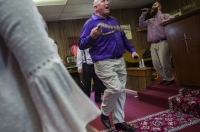
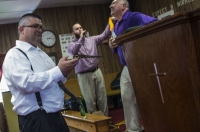
During the climax, the faithful look like they’re in a trance -- Chris was in a fever, shouting and screaming and swinging the snake around and you could just tell that he didn’t care what the snake could do to him.
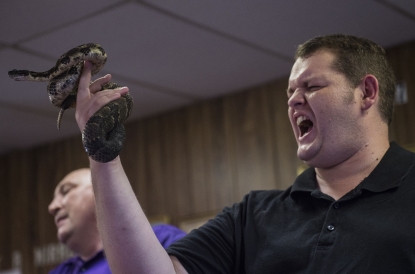 Jason Stone holds a timber rattlesnake during a Pentecostal serpent handlers service at the House of the Lord Jesus church in Squire, West Virginia on May 27, 2018.
(AFP / Andrew Caballero-reynolds)
Jason Stone holds a timber rattlesnake during a Pentecostal serpent handlers service at the House of the Lord Jesus church in Squire, West Virginia on May 27, 2018.
(AFP / Andrew Caballero-reynolds)Chris and his fellow worshippers hate the word trance because they say they’re in control the whole time and they snap out of it right away, but that is the most accurate description that I can think of.
What struck me about this particular manifestation of faith was how joyous of an affair it was. A lot of religious ceremonies that I had photographed in the past were very somber. But this was nothing like that, there was so much joy in it. It was truly a celebration of Chris’s brother’s life.
The congregation was really welcoming. It may have taken me months and countless phone calls and Facebook messages to gain their trust, but by the time they invited me out, there was no ill will or hesitation at all. They didn’t hold anything back. Whenever I’ve photographed religious believers before, they were never totally open, there was always a little bit of skepticism toward the photographer. Not here. They were as open as can be, they wanted to show us everything, as if they were saying ‘see, we’re not crazy, we just believe.”
This blog was written with Yana Dlugy in Paris.
 Randy Brandon raises his hands as he prays during a Pentecostal serpent handlers service at the House of the Lord Jesus church in Squire, West Virginia on May 27, 2018.
(AFP / Andrew Caballero-reynolds)
Randy Brandon raises his hands as he prays during a Pentecostal serpent handlers service at the House of the Lord Jesus church in Squire, West Virginia on May 27, 2018.
(AFP / Andrew Caballero-reynolds)



